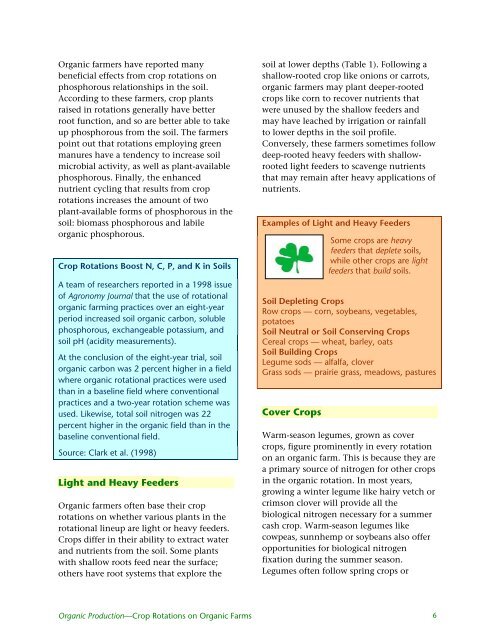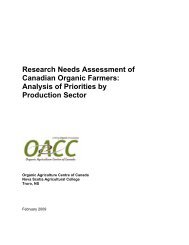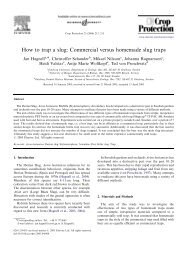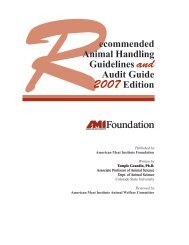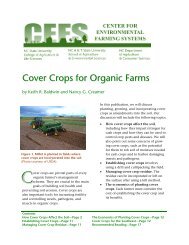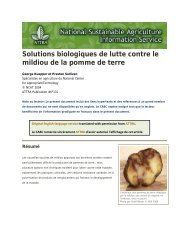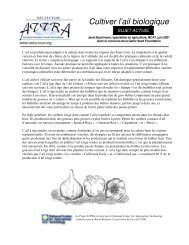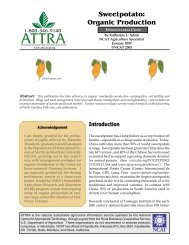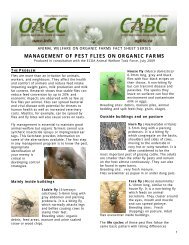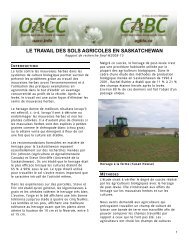You also want an ePaper? Increase the reach of your titles
YUMPU automatically turns print PDFs into web optimized ePapers that Google loves.
<strong>Organic</strong> farmers have reported manybeneficial effects from crop rotati<strong>on</strong>s <strong>on</strong>phosphorous relati<strong>on</strong>ships in the soil.According to these farmers, crop plantsraised in rotati<strong>on</strong>s generally have betterroot functi<strong>on</strong>, and so are better able to takeup phosphorous from the soil. The farmerspoint out that rotati<strong>on</strong>s employing greenmanures have a tendency to increase soilmicrobial activity, as well as plant-availablephosphorous. Finally, the enhancednutrient cycling that results from croprotati<strong>on</strong>s increases the amount of twoplant-available forms of phosphorous in thesoil: biomass phosphorous and labileorganic phosphorous.<str<strong>on</strong>g>Crop</str<strong>on</strong>g> <str<strong>on</strong>g>Rotati<strong>on</strong>s</str<strong>on</strong>g> Boost N, C, P, and K in SoilsA team of researchers reported in a 1998 issueof Agr<strong>on</strong>omy Journal that the use of rotati<strong>on</strong>alorganic farming practices over an eight-yearperiod increased soil organic carb<strong>on</strong>, solublephosphorous, exchangeable potassium, andsoil pH (acidity measurements).At the c<strong>on</strong>clusi<strong>on</strong> of the eight-year trial, soilorganic carb<strong>on</strong> was 2 percent higher in a fieldwhere organic rotati<strong>on</strong>al practices were usedthan in a baseline field where c<strong>on</strong>venti<strong>on</strong>alpractices and a two-year rotati<strong>on</strong> scheme wasused. Likewise, total soil nitrogen was 22percent higher in the organic field than in thebaseline c<strong>on</strong>venti<strong>on</strong>al field.Source: Clark et al. (1998)Light and Heavy Feeders<strong>Organic</strong> farmers often base their croprotati<strong>on</strong>s <strong>on</strong> whether various plants in therotati<strong>on</strong>al lineup are light or heavy feeders.<str<strong>on</strong>g>Crop</str<strong>on</strong>g>s differ in their ability to extract waterand nutrients from the soil. Some plantswith shallow roots feed near the surface;others have root systems that explore thesoil at lower depths (Table 1). Following ashallow-rooted crop like <strong>on</strong>i<strong>on</strong>s or carrots,organic farmers may plant deeper-rootedcrops like corn to recover nutrients thatwere unused by the shallow feeders andmay have leached by irrigati<strong>on</strong> or rainfallto lower depths in the soil profile.C<strong>on</strong>versely, these farmers sometimes followdeep-rooted heavy feeders with shallowrootedlight feeders to scavenge nutrientsthat may remain after heavy applicati<strong>on</strong>s ofnutrients.Examples of Light and Heavy FeedersSome crops are heavyfeeders that deplete soils,while other crops are lightfeeders that build soils.Soil Depleting <str<strong>on</strong>g>Crop</str<strong>on</strong>g>sRow crops — corn, soybeans, vegetables,potatoesSoil Neutral or Soil C<strong>on</strong>serving <str<strong>on</strong>g>Crop</str<strong>on</strong>g>sCereal crops — wheat, barley, oatsSoil Building <str<strong>on</strong>g>Crop</str<strong>on</strong>g>sLegume sods — alfalfa, cloverGrass sods — prairie grass, meadows, pasturesCover <str<strong>on</strong>g>Crop</str<strong>on</strong>g>sWarm-seas<strong>on</strong> legumes, grown as covercrops, figure prominently in every rotati<strong>on</strong><strong>on</strong> an organic farm. This is because they area primary source of nitrogen for other cropsin the organic rotati<strong>on</strong>. In most years,growing a winter legume like hairy vetch orcrims<strong>on</strong> clover will provide all thebiological nitrogen necessary for a summercash crop. Warm-seas<strong>on</strong> legumes likecowpeas, sunnhemp or soybeans also offeropportunities for biological nitrogenfixati<strong>on</strong> during the summer seas<strong>on</strong>.Legumes often follow spring crops or<strong>Organic</strong> Producti<strong>on</strong>—<str<strong>on</strong>g>Crop</str<strong>on</strong>g> <str<strong>on</strong>g>Rotati<strong>on</strong>s</str<strong>on</strong>g> <strong>on</strong> <strong>Organic</strong> <strong>Farms</strong> 6


